Manuscript accepted on : 8-02-2021
Published online on: 12-02-2021
Plagiarism Check: Yes
Reviewed by: Dr. Yahya Bakhtiyar
![]()
Second Review by: Dr. Ruchi Verma
![]()
Final Approval by: Dr. rer. Nat. Hesham Ali El- Enshasy
![]()
Al- Otaibi Wafa Mohammed1,2 , Khalid Mohammed Alghamdi2
, Khalid Mohammed Alghamdi2 and Jazem A. Mahyoub2,3
and Jazem A. Mahyoub2,3
1Department of Biology, Taif University, Taif, KSA.
2Department of Biological Sciences, Faculty of Science, King Abdulaziz University, Jeddah, Saudi Arabia.
3IBB University, Ibb, Republic of Yemen.
Corresponding Author E-mail: jazem2009@gmail.com
DOI : http://dx.doi.org/10.13005/bbra/2898
ABSTRACT:
The red palm weevil(RPW),Rhynchophorus ferrugineus (Olivier) (Coleoptera: Dryophthoridae) is one of the most threatening pests of date palm trees in Kingdom of Saudi Arabia (KSA). Which considered as category Iinsect pest in the Gulf region and the Middle East, according toFood and Agriculture Organization (FAO). Therefore, this research was planned to study the dynamic fluctuation of RPW, its relationship to some environmental factors (temperature & relative humidity) and to determine sexual ratio in Makkah city during 2019. In addition to clarifying color preference by using food bait pheromone traps (FBPTs). The results revealedthe presence of RPW throughout the year, with significant differences in numerical densities according to different collection times. The study also recorded the highest population density during April & March, and it was the highest significantly compared to that were collected during July, October, August and September. The study also recorded two peaks of RPW activity throughout the year. A major summit in April and a smaller summit in December. Statistical analysis results showed that the RPW has significant activity at spring compared to the other seasons, while the least active for RPW was at autumn.The results also showed a negative significant correlation between the mean population density of RPW and temperature; and a positive non-significant correlation between seasonal abundance and relative humidity, with significant differences between the mean of male and female with ratio(1:3), respectively. Black traps were more effective and significantly in attracting RPW than other tested colors.
KEYWORDS: Control; Makkah Al Mukarramah; Pheromone traps; Relative humidity; Rhynchophorus Ferrugineus; Temperature.
Download this article as:| Copy the following to cite this article: Mohammed A. W, Al-ghamdi K. M, Mahyoub J. A. The Dynamic Fluctuation of Red Palm Weevil Rhynchophorus Ferrugineus (Olivier) in Makkah Al-Mukarramah city. Biosci Biotech Res Asia 2021;18(1). |
| Copy the following to cite this URL: Mohammed A. W, Al-ghamdi K. M, Mahyoub J. A. The Dynamic Fluctuation of Red Palm Weevil Rhynchophorus Ferrugineus (Olivier) in Makkah Al-Mukarramah city. Biosci Biotech Res Asia 2021;18(1). Available from: https://bit.ly/3qdVFdx |
Introduction
The palm trees have economic importance at the global level as they are one of main food sources in many countries, as indicators confirm that palm tree cultivation is constantly growing. The number of palm trees in the world is 120 million date palms, 70% of them present in the Arab world, with a production rate of 67% and 28% of it in the Gulf countries, and that is from the global production of dates, which is estimated at about 6.7 million tons (1;2;3 &4)
Kingdom of Saudi Arabia is second largest producer of dates in the world with an estimated rate of 14.96% of the global production of dates(5&6), as there it has more than 400 cultivars of palm varieties in the world and 25of them are important (7;8&9) .The number of palm trees planted in the Kingdom of Saudi Arabia is estimated at about (28570884) palm trees, and the Makkah region contains about (1237568) palm trees (10) .
On the other hand, palm trees are affected by many insect and non-insects pests, but the RPWRhynchophorus ferrugineus (Olivier) (Coleoptera: Dryophthoridae) is one of the most dangerous invasive pests that threaten date palm trees and cause them a lot of damage and economic losses(11).The annual losses in the Middle Eastern countries are estimated by millions of dollars, with a loss of 30% of the total date production (12)
The first infection with RPW in the KSA was recorded in of Hofuf city in 1987 AD (13).Although the first recording by red palm weevil infestation in the world was on coconut palms, it was able to expand the range of its host from palm trees to (40) species, the most important of which are date palms(14;15;16&17). According to FAO It is classified as category-1 pest of date palm in the Middle-East. (5;9;18;19&20) .
Red palm weevil larvae are the most destructive stage to the palm, as they feed on the internal tissues of palm and complete their growth and development internally (20&21).This cryptic habitat of RPW affects the early detection process of infestation with it, and thus makes controlling it a difficult task, in addition this behavior provides protection from harsh climatic conditions, which enhances its presence in a wide and varied environmental range, and this is the biggest challenge facing RPW control (22).(23&24)
considered that the use of pheromone traps as part of an Integrated Management Strategy (IPM) to control RPW is an environmentally friendly tool, easy to handle, long lasting and does not make resistances .pheromone traps have been widely used in many countries of the world, including Saudi Arabia, as part of the integrated RPW control strategies (25&26) .
In view of the scarcity of recent and integrated environmental studies on the RPW in the Makkah Al Mukarramah region and based on Saudi Arabia’s vision 2030 in diversification of the Kingdom’s production base, achieving food security, by increasing the contribution of the agricultural sector to the local product, advancing economic development, and reducing the infestation of RPW from currently estimated 10% to 1%,(27).The aim of this research is to study the dynamic fluctuation and determine the seasonal variations of abundance of adults RPW and effect of temperature and relative humidity on weevils’ activity during the year in Makkah city, and the effectiveness color of pheromone traps on monitoring RPW populations.
Materials and Methods
Ecological study area
Environmental studies were carried out in the farms that are located in Makkah Al-Mukarramah Governorate in the western part of KSA Fig.(1) from January through December (2019), with the agreement of farm owners the control operations which were provide by the Ministry of Environment, Water and Agriculture to the farmers were stopped.The sites were selected on the basis of the large number of farms that were infested with theRPW, to monitoring the dynamic fluctuation of the red palm weevil during the four seasons (spring, summer, autumn and winter) and determining the relationship between the numerical density of the red palm weevil and the climatic conditions (temperature and relative humidity), by using food bait pheromone traps (FBPTs).A total of 40 traps were randomly installed according to the method describe by (28), the distance between each trap not less than 12 meters. The traps were inspected once every fortnightlyin order to collect RPWand replace freshfood baits and water.
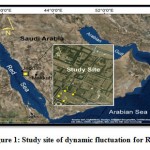 |
Figure 1: Study site of dynamic fluctuation for RPW. |
Sex ratio
The sex of adult RPW was distinguished, depending on the morphological characteristics, where the males contain bristles on the rostrum while it was absent in the females (Fig. 2)
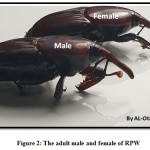 |
Figure 2: The adult male and female of RPW |
Color preference experiment
Three colors were tested (black, red and white with the natural color of burlap), where the traps were painted with the tested colors and each color had four replicates.
Statistical analysis
The completely randomized design was used, and the results were analysis using the general linear models procedure method. The statistical software, 2001 (SAS) program was used to analyze the field results and compare the averages using the least significant difference (LSD) test at the level of significance. (0.05), and the Pearson Correlation Coefficient was used to determine the relationship between the RPW population density and the climatic conditions (temperature, relative humidity).
Results
The results showed the presence of RPW in traps throughout the year, with significant differences in numerical densities according to different collection times. Atotal of 1179 RPW were collected from all the traps during the study period started at January to December. The highest population density was recorded during the month ofApril and March with mean population density (43.2 and 41.7) insect / trap respectively. It was the highest significantly compared to that were collected during July, October, August and September, but it does not differ significantly from the numerical densities which collected during May, January, December, February, June and November, as the results showed the presence of numerical differences, but they are not significant (Table 1).
The study recorded two peaks of RPW activity throughout the year. A major peakin April with theaverage density (13.0, 30.2, and 43.2) insect / trap, and a lowest peakin December, where the monthly average was about (6.5, 22.0, 28.5) insect / trap for both males, females and total adults, respectively, Table (1) and Fig.(3).
Table 1: Monthly average of red palm weevil insects in Makkah Al-Mukarramah city during 2019.
| MEAN ±S.E | Months | ||||
| Humidity | Temperature | Total | Female | Male | |
| 57.0 A±2.0 | 29.0EF ± 2.0 | 34.00 AB± 10.4 | 21.2ABC± 5.9 | 12.75 AB± 4.4 | Jan. |
| 54.0 AB±2.0 | 31.0 EF± 1.0 | 25.50ABCD ±6.2 | 18.7ABCD±5.1 | 6.75ABC±1.3 | Feb. |
| 48..0 BC±2.0 | 33.0DEF± 3.0 | 41.75 A±10.5 | 30.0A±6.5 | 11.75 AB±4.4 | Mar. |
| 42.0 CD±2.0 | 36.0BCDE±2.0 | 43.25 A± 11.1 | 30.2A±7.9 | 13.0 A±3.3 | Apr. |
| 34.0 EFG±2.0 | 39.0ABC±1.0 | 37.25 AB ± 10.8 | 27.0AB±8.2 | 10.25 AB±3.3 | May. |
| 32.0 GF±2.0 | 41.0AB±1.0 | 24.25 ABCD ±6.2 | 18.0ABCD±4.6 | 6.25 ABC±1.6 | Jun. |
| 31.0 G±2.0 | 41.0AB±1.0 | 16.75 BCD±1.6 | 11.0BCD±2.5 | 5.75BC±1.4 | Jul. |
| 38.0 DEF±2.0 | 41.0AB±1.0 | 5.50 D±3.2 | 4.0 D±2.4 | 1.5 C±0.8 | Aug. |
| 39.0 DE±2.0 | 43.0A±1.0 | 3.50 D ±1.9 | 3.2D±1.7 | 0.25 C±0.2 | Sep. |
| 48.0 BC±2.0 | 38.0 ABCD±2.0 | 10.00 CD ±4.7 | 8.5 DC±3.5 | 1.5 C±1.1 | Oct. |
| 56.0 A±2.0 | 34.0 CDEF±2.0 | 22.75 ABCD ±8.2 | 17.0ABCD±6.6 | 5.75 BC±1.6 | Nov. |
| 57.0 A±2.0 | 31.0 EF±1.0 | 28.50 ABC ±10.8 | 22.0ABC±9.8 | 6.50 ABC ±1.1 | Dec. |
| 6.1626 | 5.0318 | 22.94 | 17.082 | 7.1584 | LSD |
| 0.0001 | 0.0005 | 0.0090 | 0.0214 | 0.0051 | P |
*The averages which followed by similar letters in the same column, have no significant differences between them at level of significance (0.05)
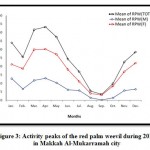 |
Figure 3: Activity peaks of the red palm weevil during 2019 in Makkah Al-Mukarramah city. |
Statistical analysis results showed that the RPW has significant activity at spring season compared to the other seasons, where the mean number of insects collected (163.0) insects / trap; while the least active for RPW was at autumn season with mean numerical density (63.0 and 48.3 ) insects / trap.Table (2) and Fig.(4).
Table 2: Seasonal fluctuation of the red palm weevil insects in Makkah Al-Mukarramah city during 2019.
| Mean ±SE | Seasons
|
||
| Total | Female | Male | |
| 115.33 AB ±11.5 | 82.6 A±3.9 | 34.6 AB ± 8.1 | Winter |
| 163.0 A ±7.2 | 116.3 A±4.1 | 46.6 A ± 3.1 | Spring |
| 63.0 BC±21.9 | 44.0 B±16.1 | 18.0 BC ±6.0 | Summer |
| 48.33 C ±22.6 | 38.33 B±16.0 | 10.0 C ± 6.6 | Autumn |
| 55.97 | 38.276 | 20.467 | LSD |
| 0.0055 | 0.0049 | 0.0131 | P |
*The averages which followed by similar letters in the same column, have no significant differences between them at level of significance (0.05).
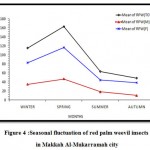 |
Figure 4 :Seasonal fluctuation of red palm weevil insects in Makkah Al-Mukarramah city. |
The results also showed a negative significant correlation between the mean population density of RPW and the temperature; where the correlation strength was (r = -0.318) and the correlation significant (P = 0.0027). The highest density was recorded in April at an average temperature of (36.0) ° C, after that decrease the number associated with an increase in the average temperature during May – August, where the lowest population density of the weevil was recorded at September at (43.0) C. With the gradual decrease in temperatures, a gradual increase in the average population density of the weevil was recorded, reaching its highest average by the end of the fourth quarter of the year (2019) during December at (31.0) ° C (Fig.5).
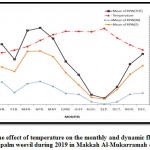 |
Figure 5 : The effect of temperature on the monthly and dynamic fluctuation of red palm weevil during 2019 in Makkah Al-Mukarramah city. |
Also the result showed a positive non-significant correlation between seasonal abundance and relative humidity where the correlation strength (r = + 0.0715) and correlation significance (P = 0.629). Then, at the beginning of the study, a relatively high average density of RPW was recorded in January at an average high relative humidity of 57%. The positive correlation between relative humidity and the seasonal abundance of the weevil appeared during the fourth quarter of the year during October, November, and December, as the traps recorded a gradual increase in the numbers of weevils with a gradual increase.
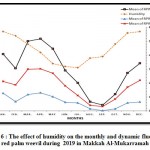 |
Figure 6 : The effect of humidity on the monthly and dynamic fluctuation of red palm weevil during 2019 in Makkah Al-Mukarramah city. |
The male to female ratio was(1:3). During the study 72% of specimens collected were identified as Females and 28 % were identified as males Table (3) and Fig.(7).
Table (3): The average of male and female red palm weevil that collected by all traps in Makkah Al-Mukarramah city.
| MEAN ±S.E | Sex |
| 13.6 B± 2.0 | Male |
| 35.1 A± 4.0 | Female |
| 9.07 | LSD |
| 0.0001 | P |
*The averages which followed by similar letters in the same column, have no significant differences between them at level of significance (0.05)
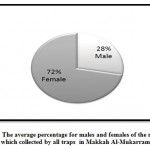 |
Figure 7: The average percentage for males and females of the red palm weevil which collected by all traps in Makkah Al-Mukarramah city. |
The color preference for RPW was tested, The result revealed that the black traps were more effective and significantly in attracting RPW than that of other tested colors, where the mean collection of one black trap was (20.3) weevil. Followed by red and white with burlap traps, which didn’t differ significantly from each other, as the average that collected by one trap was (13.5 and 10.2) weevil respectively.While the Saudi trap was the least significant in attracting the adults of the red palm weevil, with an average of 4.7 weevil per trap.Table (4) and Fig.(8).
Table 4: Red palm weevil numerical density under effect of trap color.
| Mean ±SE | Trap color
|
||
| Total | Female | Male | |
| 13.5 B ± 1.9 | 10.0 B ± 1.3 | 3.4 B ± 0.6 | Red |
| 10.2 B ± 3.1 | 7.2 B ± 1.0 | 3.0 BC ± 0.5 | White |
| 20.3 A ± 2.3 | 14.7 A ± 1.5 | 5.5 A ± 0.9 | Black |
| 4.7 C± 0.8 | 3.0 C ± 0.5 | 1.6 C ± 0.4 | Saudi |
| 4.8409 | 3.3969 | 1.8331 | LSD |
| 0.0001 | 0.0001 | 0.0007 | P |
*The averages which followed by similar letters in the same column, have no significant differences between them at level of significance (0.05)
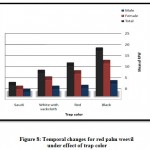 |
Figure 8: Temporal changes for red palm weevil under effect of trap color. |
Discussion
In this study, pheromone traps were used to monitor the dynamic fluctuation of RPW during all seasons (spring; summer; autumn and winter), and determine the relationship between the population density of RPW and the climatic conditions (temperature and relative humidity) ; this is consistent with in that since the beginning of the 1990s, pheromone traps have been used all over the world either to monitor and control RPW infestation in palm farms or to control it (29).
The results showed the presence of RPW throughout the four seasons, with the difference in numerical densities between months in different seasons as well as between months within a single season. This result is consistent with that found by (30&31) , who recorded the presence of the red palm weevil throughout the year.(20)reported that the population density of RPW is affected by the different climatic conditions, where the captured RPW adults differed significantly between months and during the same month; and the population density was higher in warmer seasons (32), indicated that the weevil was more active in the spring and autumn season, specifically in April and November respectively in Egypt.
The results of this study were also identical to that reported by (33), which the highest number of adults of RPW in spring season in March, April and May, in KSA and Egypt was. He also added that RPW had two activity peaks, the first one was in May and the second was in November, and the lowest density of weevil was in August. In the Middle East, the high seasonal activity of RPW was recorded during the months of March, May, September and October (34&35).
These seasonal changes in temperature and relative humidity reflect the temporal variation in RPW numbers collected by pheromone traps (36).
This difference in seasonal abundance is due to the influence of climatic factors on the activity of RPW, as many environmental studies have indicated that both of environmental parameters (temperature and humidity) affect on the activity ofRPW. This is confirmed by the results of the study that conducted by (24)which agreed with the results of the present study, where the seasonal variations of RPW abundance due to climatic conditions and added that the red palm weevil tends to rise during the spring season.
The results of their study also concluded that there was a positive relationship with high statistical significance between the number of RPW that was captured and the temperature, while a negative relationship was observed between the numbers of the weevils and the relative humidity, which is consistent with the results of the current study, as well as with what (37) that there is an effect of environmental factors on the population density of red palm weevil, as they found a direct correlation between the numbers of the weevil and the temperature and an opposite relationship with relative humidity.
The importance of environmental factors in general and temperature and relative humidity in particular on the living organisms is not hidden, as they are considered among the limiting factors for the distribution and spread of living organisms in different environments due to their joint effect on the vitality and activity of living organisms.
Each species of insect has a temperature range in which it can live, and within this range there is an optimum temperature at which the insect activity is at its peak; also within this range there are hot and cold dormancy zone , in which the temperature increases or decreases than optimum temperature, so insect’s activity begins to decline until it stops as a result of beyond the extent temperature that the insect can tolerate, which leads to its death. The same is true for humidity, as it affects the biological processes of the insect through a water imbalance, and the effect of humidity is more clear with high temperatures (38).
The insect loses water in response to the increase of temperature in the surrounding environment. The loss process done through the spiracles; cuticular and by excretory system, but 90% of transpiration is via the cuticle, this layer consists of three layers one of them is epicuticle and the lipid layers that present in its structure are one of the main substrates that hinder water loss.
The results of (39)study shown the physiological basis to explaining the effect of drought on RPW; they isolated and identified ten hydrocarbons compounds the weevil cuticle. Seven of them were un-branched saturated n-kinases (n-Heptadecane; n-Nonadecane; n-Heneicosane; n-Tricosane; n-Pentacosane; n-Nonacosane and n-hexatriacontane) and they represent 75%, while the fatty alcoholic compound (3- (E) Eicosanol) ; the ester compound (1-Henicosyl formate) and the unsaturated alkene compound (Tricosene) represented 17-25% of the total hydrocarbons.(40)added that at a rather high environmental temperature, most of the saturated un-branched hydrocarbons take a solid crystalline form and thus prevent water loss,also the study results that carried out by (41)showed the temperatures which required to dissolve these compounds, where the temperature for most saturated un-branched hydrocarbons ranged between (41 – 76) C°, which explains the ability of red palm weevil to prevent the water loss from its bodies under high temperature and low humidity. As for the rest of the unsaturated compounds, their melting point is less than 21C ° .(39) added that, based on previous studies, 25% of the hydrocarbons in RPW cuticle are in liquid form at temperatures below 20C ° , where they act as large pores that precipitate through the wax cover. Thus, the large rate deposition of these compounds in the cuticle of RPW may be responsible for the high water loss rates that are attributed to insect death under high temperature and low relative humidity.
Furthermore, the temperature and relative humidity have an effect on the growth and development of RPW, starting from eggs laying; hatching success; larval development and ability to emerge as an adult insect, as mentioned by a lot of scientific research (42; 43; 44; 45; 46 &47).This explains the relationship of tested climatic factors to the dynamic fluctuation and seasonal abundance of red palm weevil.
In addition, the present study aimed to determine the sexual ratio of adults red palm weevil that captured by pheromone traps during the study period.The results showed significant differences between the mean number of males and females, where females were the most significant, this agree with many scientific studies (16; 33; 48; 49; 50; 51; 52; 53; 54 &55).
In a study conducted during 2018 and 2019 to compare the effectiveness of two types of traps used to control RPW in Egypt, the results showed that there was no significant difference between the total number of RPW collected by the two tested traps. While there was a significant difference between the number of males and females, where the sexual ratio between males and females was (1: 1.43 and 1: 1.94) during 2018 and 2019, respectively, (56).In another experiment by (37). to follow up the red palm weevil, it was found that the number of females collected exceeds the number of males, with ratio of males to females (3.1: 1).
In the current study, the increased number of females may be due to they may have a higher sensitivity to aggregation pheromone than males and this has been confirmed by previous studies, as mentioned by (57)where they found that females of RPW respond to aggregation pheromone more than males.
(58)also indicated that females of RPW have more basioconic sensillae on antenna than males, as it is known that these basioconic sensillae are sensitive to aggregation pheromone (59).
Also, as a result of feeding the larvae and crowding the palm with the different stages of RPW , the host becomes of poor quality. Thus, it is necessary to leave the this host and search for another host for laying eggs to ensure continuity of survival; perhaps the reason is that the females search for males for mating, so the females are sensitive to the aggregation pheromone, which explains the increase number of females over males in pheromone traps.
Or perhaps reason of more females over males is due to their higher levels of activity. This is confirmed by previous studies and current result in that the majority of captured females are young and fertile(49&60), which enhances the use of pheromone traps as a tool of monitoring and controlling red palm weevil infestation, because it reduces the numerous densities as a result of captured fertile females thus, the infestation decreases through lack of laying eggs, which serves integrated management to control red palm weevil.
In many scientific studies and researches, focus has been on the design and color of the trap; the pheromone and the kermon which used in it and the duration of their change as variables affecting the success of RPW control process using food bait pheromone traps (55&61).
In the ourstudy, the color preference of RPW was tested, and the results showed that black-colored traps were more effective and more significant in attracting red palm weevil adults compared to the tested colors, and this is in agreement with many scientific studies (36; 54; 62;63 64 &65 ).
The main reason for red palm weevil’s attraction to black trap is that the black color wavelength spectrum is very similar to the palm tree fibers when analyzing the spectral reflectance of the tested colors and some plant tissues, which leads to the attraction of the weevil adults to black traps. More compared to other colors (66); or due to the black color absorbs more sunlight compared to other colors which leads to a high temperature in black traps, that might cause greater pheromone release, which result in increase insect captures (67).
Conclusions
Environmental studies concluded that the RPW was present in traps throughout the year, The study recorded the highest population density during April and March, and two peaks of weevil activity in April and in December. The spring season witnessed significant activity of weevil; with a negative significant correlation between the mean population density of weevil and the temperature; and a positive non-significant correlation with relative humidity. Also the females were the highest density significant Compared with males. The black traps were more effective and more significant in attracting weevils adults than the tested colors.
Acknowledgments
We are very grateful to the farms owners for allowing us to work throughout the study period; and Ministry of Environment, Water and Agriculture branch in Makkah Al-Mukarramah, KSA andDr. Khalid Ali Asiri, the head of Arid Land Agriculture Department, King Abdulaziz University for help .
Conflict of Interest
There is no conflict of interest.
Funding Source
none
References
- Erskine, W.; Moustafa, A. T.; Osman, A. E.; Lashine, Z.; Nejatian, A. and Badawi, T. (2004) Date palm in the GCC countries of the Arabian Peninsula, Regional Workshop on Date Palm development in the Abu Dhabi, Ministry of Education and scientific research, UAE.
- Kader, A. A. and Hussein, A. (2009) Harvesting and postharvesting handling ofdates, International Center for Agricultural Research in the Dry Areas (ICARDA), Aleppo, Syria.
- El-Juhany, L. I. (2010) Degradation of date palm trees and date production in Arab countries: Causes and potential rehabilitation, Australian Journal of Basic and Applied Sciences , 4(8): 3998-4010.
- Sewify, G.H. (2013) Red palm weevil problem and solution, Scientific publishing center, KAU.
- Sallam, A.A.; El-Shafie, H.A.F. and Al-Abdan, S. (2012) Influence of farming practices on infestation by red palm weevil Rhynchophorus ferrugineus (Olivier) in date palm: a case study, International Research Journal of Agricultural Science and Soil Science, Vol. 2(8) pp. 370-376.
- Siddiq, M. and Greiby, I. (2014) Overview of date fruit production, postharvest handling, processing and nutrition dates, Postharvest Science, Processing Technology and Health Benefits, First Edition.
CrossRef - Anonymous (2009) Annual statistical data (Ed. Department of studies, planning and statistics, Ministry of Agriculture, Kingdom of Saudi Arabia). 269p.
- Ashraf, Z. and Hamidi-Esfahani, Z. (2011) Date and date processing: a review, Food Reviews International, 27: 101-133.
CrossRef - Al-Hudaib, K.; Ajlan, A. and Faleiro, (2017) Genetic Diversity among Rhynchophorus ferrugineus Populations from Saudi Arabia and India, Scientific Journal of King Faisal University (Basic and Applied Sciences) 19:(1).
- National Palm and Dates Center (2018) Semi-annual report,Riyadh.
- Milosavljevic, I.; El‑Shafie, H.A.F.; Faleiro, J. R.; Hoddle, C.D.; Lewis, M. and Hoddle, S. (2019) Palmageddon: the wasting of ornamental palms by invasive palm weevils, Rhynchophorusspp, Journal of Pest Science, 92: 143-156.
CrossRef - Al-Ayedh, H. (2016) Global research review of red palm weevil (RPW) Rhynchophorus ferrugineus, Life science and environment research institute king Abdulaziz city for science and technology.
- Al-Abdulmohsin, A. M.H. (1987) The First Record of the Red Palm Weevil in the Kingdom of Saudi Arabia, Agriculture in the Arab World, 3 (9): 15-16.
- Ojeu, (2008) Commission decision of 6 October 2008 amending decision of 2007/365/EC on emergency measures to prevent the introduction into and the spread within the community of Rhynchophorus ferrugineus (Olivier) 2008/5550/C, Official J. European Union L 266: 14.
- Anonymous (2013) Save Algarve palms.http://www.savealgarvepalms.com/en/weevilfacts/ host-palm-trees (accessed on 1/8/2020).
- AL- Saroj, S.; AL-Abdallah, E.; AL-Shawaf, A.; AL-Dandan, A.; AL-Abdullah, I.; AL-Shagag, A.; AL-Fehaid, Y.; Abdallah, A.B. and Faleiro, J.R.(2017) Efficacy of bait free pheromone trap (ElectrapTM) for management of red palm weevil, Rhynchophorus ferrugineus (Olivier) (Coleoptera: Curculionidae, Pest Management in Horticultural Ecosystems, Vol. 23, No. 1 pp 55-59 .
- (2020) Rhynchophorus ferrugineus, EPPO datasheets on pests recommended for regulation. Available from: https://gd.eppo.int [Accessed: 15 May 2020]
- Zaid, A, De Wet PF, Djerbi, M , Oihabi A (2002) Date palm cultivation, The semi-annual report of National Center for Palms and dates.
- Anonymous (2004) Proceedings of the date palm regional workshop on ecosystem based IPM for date palm in the Gulf Countries, Al-Ain, United Arab Emirates. UAE .
- Faleiro, J. R. (2006) A review on the issues and management of red palm weevil Rhynchophorus ferrugineus (Coleoptera: Rhynchophoridae) in coconut and date palm during the last one hundred years, International Journal of Tropical Insect Science, 26(3): 135-154.
- Faleiro, J. R. (2004) Pheromone based strategy for the management of red palm weevil in date palm and coconut agro-ecosystems: Implications, protocols and impact. Pages 44-52 in Proceedings of The Date Paper presented at Date Palm Regional Workshop on Ecosystem based IPM for Date Palm in the Gulf Countries UAE University, Al-Ain, UAE; 28-30 .
- Faleiro, J.R.; Ferry, M.; Yaseen, T. and Al-Dobai, (2019b) Overview of the gaps, challenges and prospects of red palm weevil management. In: Presented at the International Scientific Meeting on ‘Innovative and Sustainable Approaches to Control the Red Palm Weevil, Arab Journal of Plant Protection. 37(2):170-177.
CrossRef - Kaakeh, W. (2000) The use of synthetic pheromones in integrated pest management program (Review), Emirates J. Agri. Sci., 12: 1-32.
- El-Bokl, M. M.; Sallam, A. M.; Abdallah, G. and Gabr, B. M.(2015) Efficacy of aggregation pheromone in trapping red palm weevil (Rhynchophorus ferrugineus Olivier) infested Date palms in Damietta, Egypt, Egyptian Academic Journal of Biological Sciences C. Physiology & Molecular Biology. 7(1): 51 – 59.
CrossRef - Abbas, M. S. T. Hanounik, S. B.; Shahdad, S. and Aibagham, S. A. (2006) Aggregation pheromone traps, a major component of IPM strategy for the red palm weevil, Rhynchophorus ferrugineus in date palms (Coleoptera: Curculionidae), J. Pest Sci. 79: 69-73.
CrossRef - Faleiro, J. R.; Ben Abdullah, A.; Kumar, J.A.; Shagagh, A. and Al Abdan, S. (2010) Sequential sampling plan for areawide management of Rhynchophorusferrugineus(Olivier) in date palm plantations of Saudi Arabia, J. Trop.Insect Sci., 30: 145-153.
CrossRef - Bob, M. A. (2019) Management of the red palm weevil Rhynchophorus ferrugineus (Olivier) using sustainable options in Saudi Arabia, Arab J. Pl. Prot. Vol. 37, No. 2.
CrossRef - Oehlschlager, ( 2006) Mass trapping as a strategy for management of Rhynchophorus palm weevils, In: I jornada internacionalsobre el picudorojo de las palmeras.- Fundación agroalimed, Valencia, Spain. , pp. 143-180.
- Faleiro, J.R.; Al-Shawaf, A.-M.; El-Shafie, H.A.F. and Pai Raikar. S. (2019a) Studies on service free semiochemical mediated technologies to control red palm weevil Rhynchophorus ferrugineus Olivier based on trials in Saudi Arabia and India, Arab Journal of Plant Protection, 37(2): 136-142.
CrossRef - Abdallah, F. F. and Al-Khatri, S. A. (2003) Seasonal fluctuation of Rhynchophorusferrugineus(Oliv.) Coleoptera – Curculionidae) in the Sultanate of Oman, International conference on date palm (2003) kingdom of Saudi Arabia king Saud University.
- Maruthadurai, R. and Ramesh, R. (2020) Mass trapping of red palm weevil and rhinoceros beetle in coconut with aggregation pheromone, Indian Journal of Entomology, 82(3), 439-441.
CrossRef - El-Sebaey, Y. (2003) Ecological studies on the red palm weevil, Rhynchophorusferrugineus (Coleoptera: Curculionidae) in Egypt, Egypt. J. Agric. Res., 81 (2):523-529.
- Faleiro, J. R .(2005) Insight into the management of red palm weevil Rhynchophorus ferrugineus Olivier: based on experiences on coconut in India and date palm in Saudi Arabia,FundacionAgroalimed. I Jornada Internacionalsobre el PicudoRojo de las Palmeras, November 27-29, pp. 35-57.
- Dembilio, O.; Riba, J.M.; Gamon, M. and Jacas, J.A. (.2015) Mobility and efficacy of abamectin and imidacloprid against Rhynchophorus ferrugineus in Phoenix canariensisby different application methods, Pest Management Science, 71(8): 1091-1098.
CrossRef - Milosavljevic, I.; El-Shafie, A.F.; Faleiro, J.R.; Hoddle, C.D.; Lewis , M.; Hoddle, M.S. and Palmageddon (2018) The wasting of ornamental palms by invasive palm weevils, Rhynchophorus spp, Journal of Pest Science. 2018;92:143-156
CrossRef - Al Saoud , A.H.; AL-Deeb, M.A. and Murchie, A.K. (2010) Effect of color on the trapping effectiveness of red palm weevil pheromone traps, Journal of Entomology,7(1):54-59.
CrossRef - Firdaus, M. M.; Chuah, T. S. and Wahizatul, A. A. (2020) Synergistic Effect of Synthetic Pheromone and Kairomone-Releasing Food Baits in Mass Trapping System of Red Palm Weevil, Rhynchophorus ferrugineus. In IOP Conference Series: Earth and Environmental Science (Vol. 494, No. 1, p. 012015). IOP Publishing .
CrossRef - Al-Mahmadi, Ruqayya. M. A. (2011) General Entomology, Scientific Publishing Center, King Abdulaziz University.
- Monzer, M.A. and Srour, A. (2009) Desiccation intolerance of the red palm weevil, Rhynchophorus ferrugineus(oliv) adults in relation to their cuticular hydrocarbons, Egypt. Acad. J. biolog. Sci., 2(1): 47-53 .
CrossRef - Woodrow, R. J.; Grace, J. K.; Nelson, L. J. and Haverty, M. I. (2000) Modification of cuticular hydrocarbons of cryptotermes brevis (isopteran: Kalotermitidae) inresponse to temperature and relative humidity, Environ. Entomol. 29(6):1100-1107.
CrossRef - Gibbs, A.G. (2002).Lipid melting and cuticular permeability: new insights into an old Problem, Insect Physiol. 48: 391- 400
CrossRef - Martin, M. and Garcia, T.C.( 2006) Manejo de la cría del picudorojo de la palmera,” Rhynchophorus ferrugineus (olivier, 1790) (coleoptera, dryophthoridae), endietaartificialyefectosensubiometríaybiologia, Boletin de sanidad vegetal. Plagas. 32:631-642.
- Al‐Ayedh, H. and Rasool, K. (2010) Sex ratio and the role of mild relative humidity in mating behaviour of red date palm weevil Rhynchophorus ferrugineus. (coleoptera:Curculionidae) gamma‐irradiated adults, J. App. Entomol. 134:157-162.
CrossRef - Li, L.Q.; Wei-Quan, M.; Zi-long,Y.; Wei,H.; Shan-chun and Pen,Z.Q.(2010) Effect of temperature on the population growth of Rhynchophorus ferrugineus (Coleoptera: Curculionidae), on sugarcane, Environmental Entomology, 39(3): 999-1003.
CrossRef - Dembilio,O. and Jacas, J. A. (2011)Basic bio-ecological parameters of the invasive red palm weevil, weevil Rhynchophorus ferrugineus (Coleoptera: Curculionidae) in Phoenix canariensis under Mediteranean climate, Bulletin of Entomological Research, 101 (2): 153-163.
CrossRef - Dembilio, O.; Tapia, G.V.; Tellez, M.M. and Jacas, J. A. (2012) Lower temperature thresholds for oviposition and egg hatching of the Red Palm Weevil, Rhynchophorus ferrugineus (Coleoptera: Curculionidae), in a Mediterranean climate,Bulletin of Entomological Research, 97-102.
CrossRef - El-Shafie, H.A.F.; Faleiro, J.R.; Abo-El-Saad, M.M. and Aleid, S.M.(2013) A meridic diet for laboratory rearing of Red Palm Weevil, Rhynchophorus ferrugineus (Coleoptera: Curculionidae), academic Journals, Vol.8(39),pp. 1924-1932.
- Vidyasagar, P.; Mohammed, H.; Abozuhairah, R.; ALMohanna. O. and AL-Saihati, A. (2000) Impact of mass pheromone trapping on red palm weevil adult population and infestation level in date palm gardens of Saudi Arabia, Planter, 76 (891): 347-355.
- Abraham, V. A.; Faleiro, J. R.; AL Shuaibi, M. A. and AL Abdans, S. (2001) Status of pheromone trap captured female red palm weevils from date gardens in Saudi Arabia J. Trop. Agric. 39: 197-199.
- Faleiro, J.; Kumar J.A. and Rangnekar, P. (2002) Spatial distribution of red palm weevil Rhynchophorus ferrugineus oliv (coleoptera: Curculionidae) in coconut plantations, Crop Prot. 21:171-176.
CrossRef - Abdallah, F. F. and AL-Khatri, S. A. (2005) The effect of pheromone, kairomone and food bait on attracting adults of red palm weevil Rhynchophorus ferrugineus in the Sultanate of Oman in Date palm plantations, Egyptian Journal of Agricultural Research, 83: 169-177.
- Al Saoud , A.H. (2007) Importance of Date Fruit in the Red Palm Weevil, Rhynchophorus Ferrugineus Olivier (Coleoptera: Curculionidae), Aggregation Pheromone Traps, Rsearchgat, 405-411.
CrossRef - Jayanth, K. P.; Mathew, M. T.; Narabenchi, G. B. and Bhanu, K. R. M. (2007) Impact of large scale mass trapping of red palm weevil Rhynchophorus ferrugineus Olivier in coconut plantations in Kerala using indigenously synthesized aggregation pheromone lures, Indian Coconut J. 38: 2-9.
- Vacas, S.; Primo, J. and Navarro-Llopis, V. (2013) Advances in the use of trapping systems for Rhynchophorus ferrugineus (Coleoptera: Curculionidae): Traps and attractants, Journal of Economic Entomology 106: 1739-1746.
CrossRef - Vacas, S.; Abad-Paya, M.; Primo, J. and Navarro-Llopis, V. (2014) Identification of pheromone synergists for Rhynchophorus ferrugineus trapping systems from Phoenix canariensispalm volatiles, Agric. Food Chem. 62: 6053-6064.
CrossRef - Abd El-Wahaba, A. S.; Abd El-Fattaha, A. Y.; El-Shafeib, W. K. M. and El-Helalya, A. A. (2020) Efficacy of aggregation nano gel pheromone traps on the catchability of Rhynchophorus ferrugineus (Olivier) in Egypt, Brazilian Journal of Biology.
CrossRef - Poorjavad, N.; . Goldansaz, S. H and Avand-faghih, (2009) Response of the red palm weevil Rhynchophorus ferrugineus to its aggregation pheromone under laboratory conditions, Bull. insectol., 62:257-260.
- Avand-Faghih, A. (2004) Identification et application agronomique de synergistesvegetaux de la pheromone du charançonRhynchophorus ferrugineus (Olivier) 1790, These pour obtenir le titre de docteur de l’INA-PG, Institut National Agronomique Paris-Grignon et Institut National de la Recherche Agronomique, France.
- Said, I.; Tauban, D.; Rrnou, M.; Mori, K. and Rochat, D. (2003) Structure and function of the antennal sensilla of the palm weevil Rhynchophorus palmarum (Coleoptera, Curculionidae), Journal of Insect Physiology, 49: 857-872.
CrossRef - Faleiro, R.l; Rangnekar, P. A. and Satarkar, V. R. (2003) Age and fecundity of female red palm weevils Rhynchophorus ferrugineus (Olivier) (Coleoptera: Rhynchophoridae) captured by pheromone traps in coconut plantations of India, Crop Prot. 22: 999- 1002.
CrossRef - Jaques, A. (2020) Guidelines on visual inspection for early detection of red palm weevil in Canary Island palm (Phoenix canariensis), In: Elkakhy M, Faleiro JR, editors. Red Palm Weevil: Guidelines on Management Practices. Rome: FAO
- Abuagla, A. and Al- Deeb, M. (2012 ) Effect of bait quantity and trap color on the trapping efficacy of the pheromone trap for the red palm weevil, Rhynchophorus ferrugineus, Journal of Insect Science, 12 (120): 1-6.
CrossRef - Al Saoud , A.H. (2013) Effect of ethyl acetate and trap colour on weevil captures in red palm weevil Rhynchophorus ferrugineus (Coleoptera: Curculionidae) pheromone traps, International Journal of Tropical Insect Science, 33 (3): 202- 206.
CrossRef - Abdel-Azim, M.M.; Khan, R.; AL-Dosari, S. Vidyasagar, P.; Ibrahim, S. and Shukl, P. (2014) Studies for colour-selection of Rhynchophorus ferrugineus pheromone trap, Journal of Plantation Crops, 42 (3): 386-391.
- Avalos, J.A. & Soto, A. (2015) Study of chromatic attraction of the red palm weevil,Rhynchophorus ferrugineus using bucket traps,Bulletin of Insectology 68 (1): 83-90.
- Maso, J.A.A. (2015) Factors influencing the mobility of Red palm weevil Rhynchophorus ferrugineus (Coleoptera: Dryophthoridae) adults, Ph.D. Thesis, UniversitatPolitecnica De Valencia
- Hallett, R.H.; Oehlschlager A.C. and Borden, J.H. (1999) Pheromone trapping protocols for the asian palm weevil, Rhynchophorus ferrugineus (coleoptera: Curculionidae), Int. J. Pest Manage. 45:231-237.
CrossRef

This work is licensed under a Creative Commons Attribution 4.0 International License.





